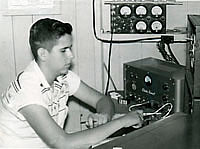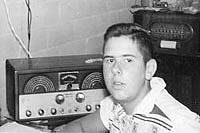Bernie Huth, Ph.D., W4BGH
(formerly KN8BVB)
I was intrigued by the description of a crystal radio in my Cub Scout book. The idea that a radio could be made out of those simple parts stuck in my head, and years later I asked my high school science teacher how a radio signal could pass between those two coils of wire in the crystal set when there wasn't any direct connection.
 There was no answer until I found amateur radio in my sophomore year of high school. The fathers of two friends in my small Ohio town were active hams - Paul Kindy, W8UKT and Bob Castle, W8BTT. For reasons that I no longer remember, the three of us decided to get our Novice licenses. So at 15 years of age in 1956 Ron Kindy, Dick Castle, and I started to learn the Morse code and study the license manual with the help of Paul Kindy. I still have my copy of the 1955 Radio Amateur's Handbook. Paul had a station in his family room and we would listen to CW on his receiver to supplement our code practice oscillators. There was no answer until I found amateur radio in my sophomore year of high school. The fathers of two friends in my small Ohio town were active hams - Paul Kindy, W8UKT and Bob Castle, W8BTT. For reasons that I no longer remember, the three of us decided to get our Novice licenses. So at 15 years of age in 1956 Ron Kindy, Dick Castle, and I started to learn the Morse code and study the license manual with the help of Paul Kindy. I still have my copy of the 1955 Radio Amateur's Handbook. Paul had a station in his family room and we would listen to CW on his receiver to supplement our code practice oscillators.
My mother helped me learn the Morse code: No...she didn't know the code, but in the beginning was able to read the dots and dashes fast enough to send them to me with my surplus J-38 key. Eventually the day came for our test, and Paul Kindy administered my Novice license exam. All three of us passed and then we started the long wait for our licenses to arrive in the mail.
Amateur radio equipment was quite a bit different in those days, and was a mixture of purchased gear and World War II surplus. Paul Kindy had an E.F. Johnson Viking transmitter with a kilowatt amplifier and a National NC-183D receiver. Bob Castle's station was comprised of surplus ARC-5s and a Hammarlund HQ-100 receiver.
My parents bought a Hallicrafters SX-99 for me, and when I was waiting for my license to be issued I purchased a Globe Scout transmitter kit from World Radio Laboratories in Council Bluffs, Iowa. It was my first experience with electronics assembly and the experience was remarkable in that it worked with only a few solder joints requiring reheating.
 The wait for my license was almost unbearable. The normal waiting time was six-weeks, and when it didn't come on schedule I met the mailman at my front door each day looking for that letter from the FCC. After eight-weeks it finally came with my new call, KN8BVB. Dick Castle was KN8BUY and Ron Kindy was KN8CDF. We had just missed a treasured "W8" call by a few months The wait for my license was almost unbearable. The normal waiting time was six-weeks, and when it didn't come on schedule I met the mailman at my front door each day looking for that letter from the FCC. After eight-weeks it finally came with my new call, KN8BVB. Dick Castle was KN8BUY and Ron Kindy was KN8CDF. We had just missed a treasured "W8" call by a few months
My first antenna was a "Windom" off-center-fed dipole using 300-ohm twin lead transmission line and a B&W air balun. So with a handful of crystals for my Globe Scout I began my adventures as a ham. I can still remember the thrill of hearing my call sign being tapped out in code by an unseen operator perhaps thousands of miles away.
My "shack" which was a former "coal cellar" in the basement that was cleaned up and repainted after the furnace was converted to natural gas. So with handful of crystals sitting in front of the Globe Scout transmitter I began my amateur radio "career."
Solar cycle 19 was providing good conditions in 1956 - 1957, and the 15-meter Novice band quickly became my favorite. The learning experience was not all positive and I discovered the design weakness of television sets with 21 MHz IF frequencies.
Dick Castle and I went on to General class "tickets" with a trip to the FCC offices in Cleveland, Ohio, and the two of us also earned commercial radiotelephone licenses.
Amateur radio was an important factor in shaping my career. I was one of 400 finalists in the Westinghouse Science Talent Search in my Senior year in high school with a transistorized amateur transmitter project. I went on to win a 4-year scholarship to Case Institute of Technology and earn a Bachelors degree in electrical engineering. I borrowed heavily from an article in QST for my senior project at Case on a microwave parametric amplifier using a varactor diode.
I traveled across the country to Stanford University eventually earning MS and Ph.D degrees in electrical engineering. One summer Iworked in Stanford's Radioscience Laboratory headed by Oswald Garrison Villard, Jr., W6QYT (SK). Villard was one of those credited with introducing Single Sideband modulation to amateur radio, and this exposure to him was a rare opportunity for me as a young engineer.
I am now retired after my career in electrical engineering, but I'm still very active in amateur radio. My call is W4BGH and is a tribute to my "vanity" because it is my initials (and I finally got the "W" callsign I so narrowly missed in 1956.) I am most active on 20-meter PSK31, but still have an occasional CW or SSB contact. There is also a Linux-based FPAC-networked packet station running 24x7 next to my HF equipment providing a Winlink 2000 gateway to the Internet.
I haven't forgotten my "Elmer," Paul Kindy, who passed away in 1983, and consider him my inspiration to help newer hams study for their license exams or explore the many facets of amateur radio. You never know when this hobby will be "life changing!"
|